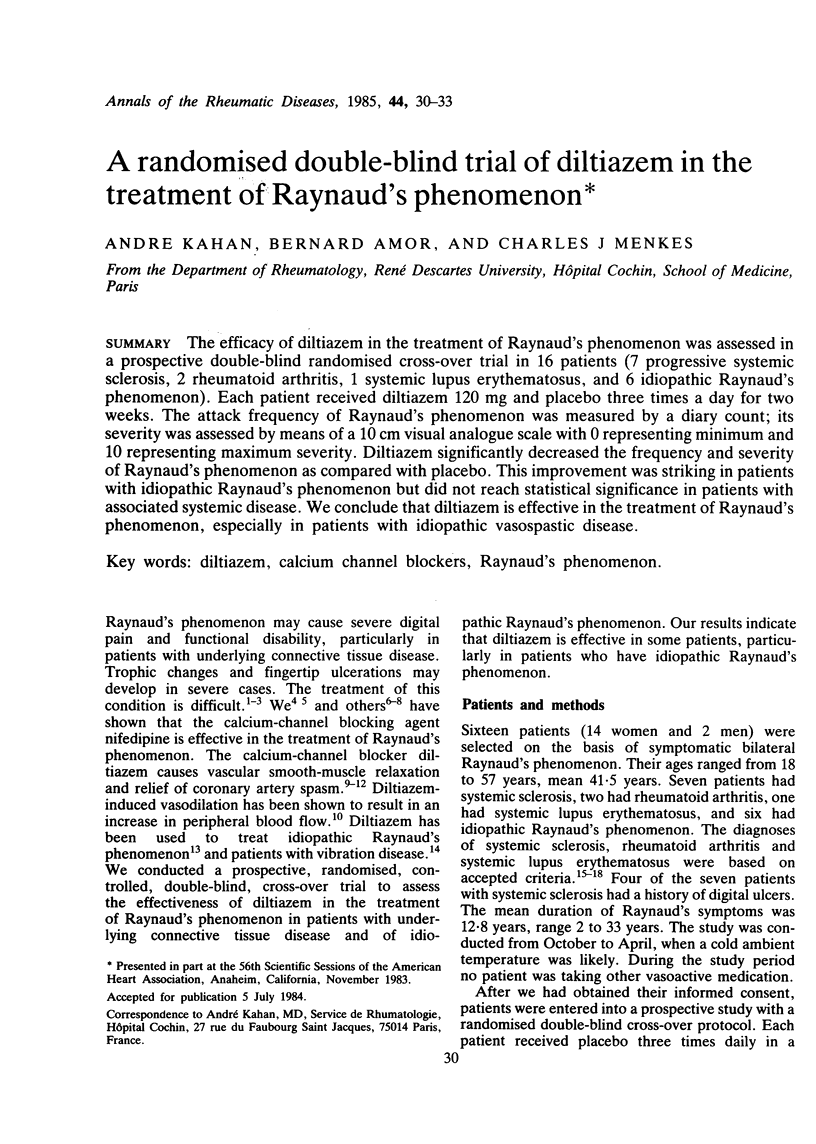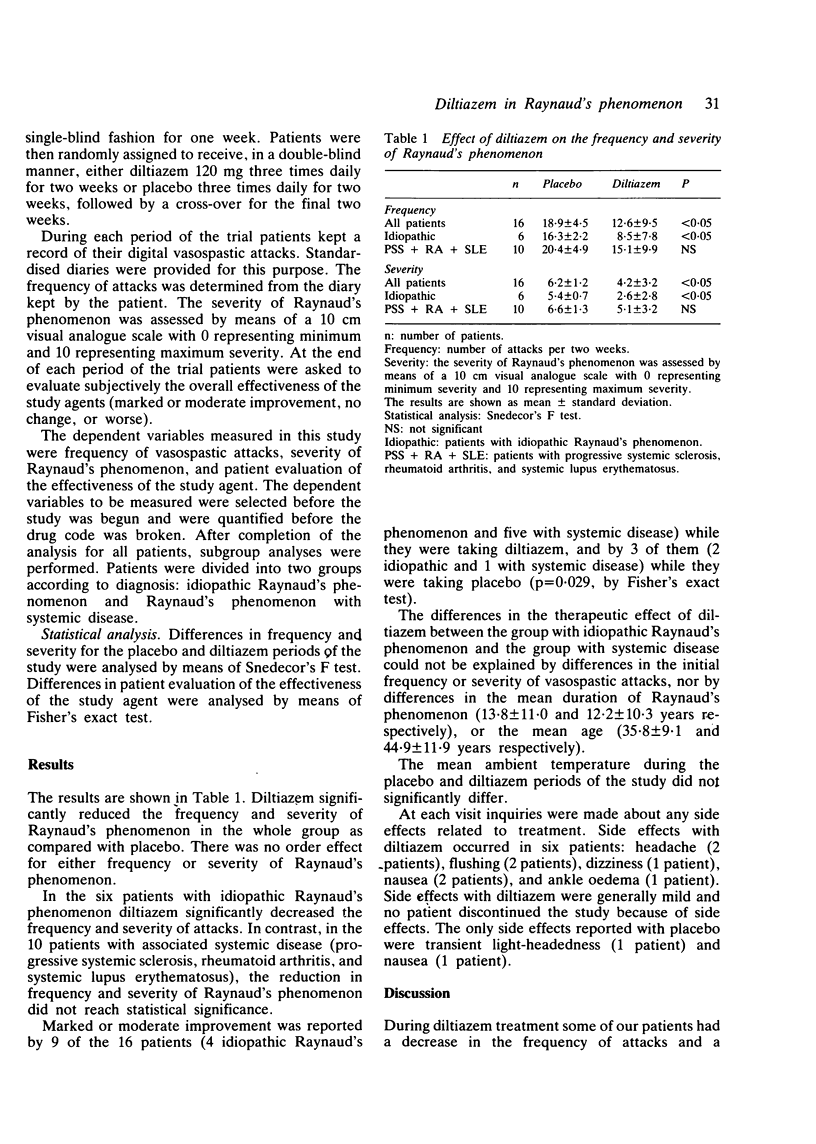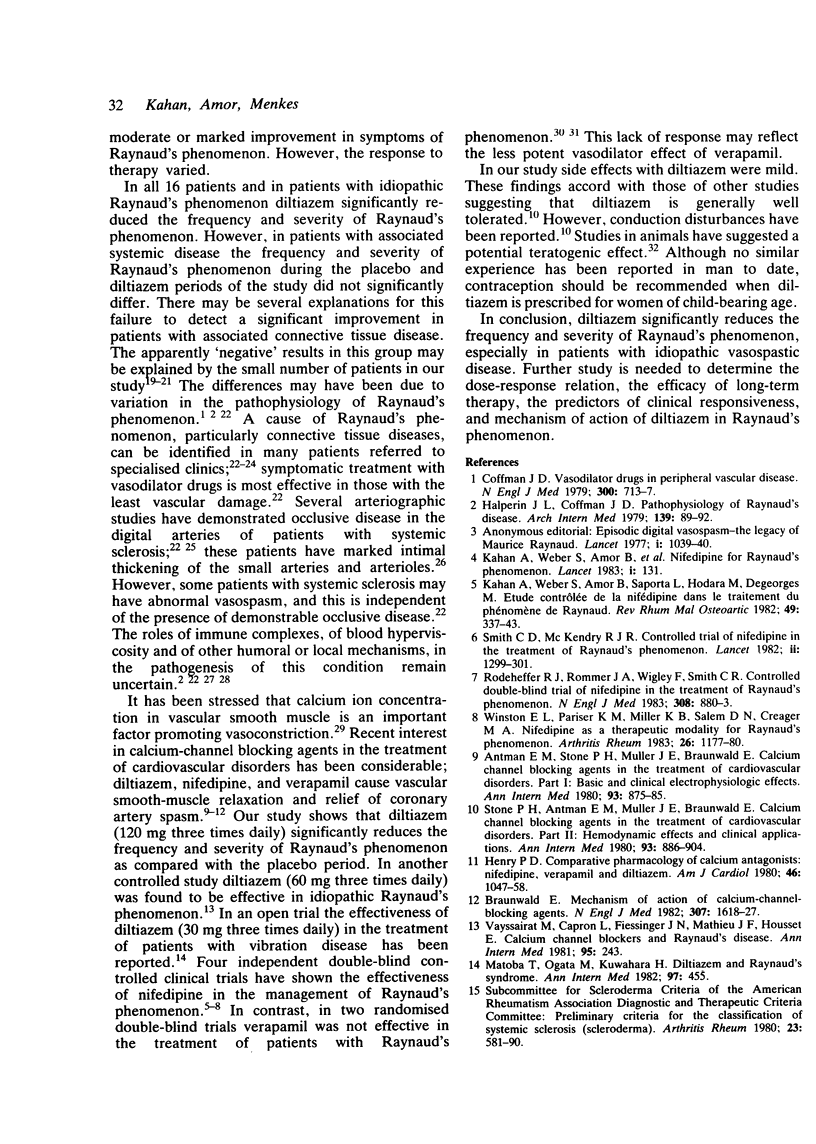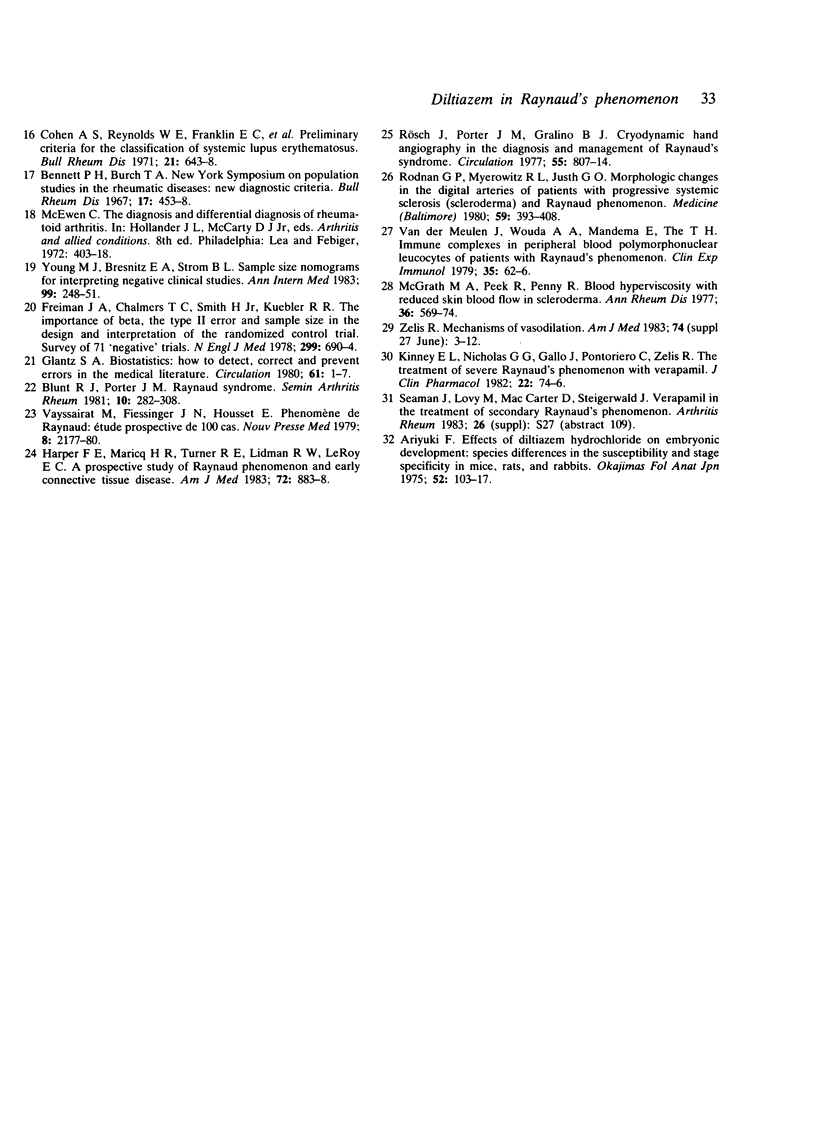Abstract
The efficacy of diltiazem in the treatment of Raynaud's phenomenon was assessed in a prospective double-blind randomised cross-over trial in 16 patients (7 progressive systemic sclerosis, 2 rheumatoid arthritis, 1 systemic lupus erythematosus, and 6 idiopathic Raynaud's phenomenon). Each patient received diltiazem 120 mg and placebo three times a day for two weeks. The attack frequency of Raynaud's phenomenon was measured by a diary count; its severity was assessed by means of a 10 cm visual analogue scale with 0 representing minimum and 10 representing maximum severity. Diltiazem significantly decreased the frequency and severity of Raynaud's phenomenon as compared with placebo. This improvement was striking in patients with idiopathic Raynaud's phenomenon but did not reach statistical significance in patients with associated systemic disease. We conclude that diltiazem is effective in the treatment of Raynaud's phenomenon, especially in patients with idiopathic vasospastic disease.
Full text
PDF



Selected References
These references are in PubMed. This may not be the complete list of references from this article.
- Antman E. M., Stone P. H., Muller J. E., Braunwald E. Calcium channel blocking agents in the treatment of cardiovascular disorders. Part I: Basic and clinical electrophysiologic effects. Ann Intern Med. 1980 Dec;93(6):875–885. doi: 10.7326/0003-4819-93-6-875. [DOI] [PubMed] [Google Scholar]
- Ariyuki F. Effects of diltiazem hydrochloride on embryonic development: species differences in the susceptibility and stage specificity in mice, rats, and rabbits. Okajimas Folia Anat Jpn. 1975 Aug;52(2-3):103–117. doi: 10.2535/ofaj1936.52.2-3_103. [DOI] [PubMed] [Google Scholar]
- Blunt R. J., Porter J. M. Raynaud syndrome. Semin Arthritis Rheum. 1981 May;10(4):282–308. doi: 10.1016/0049-0172(81)90006-8. [DOI] [PubMed] [Google Scholar]
- Braunwald E. Mechanism of action of calcium-channel-blocking agents. N Engl J Med. 1982 Dec 23;307(26):1618–1627. doi: 10.1056/NEJM198212233072605. [DOI] [PubMed] [Google Scholar]
- Coffman J. D. Drug therapy: vasodilator drugs in peripheral vascular disease. N Engl J Med. 1979 Mar 29;300(13):713–717. doi: 10.1056/NEJM197903293001305. [DOI] [PubMed] [Google Scholar]
- Edwards J. H. DNA probes in X-linked disease. Lancet. 1983 Jan 15;1(8316):131–132. doi: 10.1016/s0140-6736(83)91778-6. [DOI] [PubMed] [Google Scholar]
- Freiman J. A., Chalmers T. C., Smith H., Jr, Kuebler R. R. The importance of beta, the type II error and sample size in the design and interpretation of the randomized control trial. Survey of 71 "negative" trials. N Engl J Med. 1978 Sep 28;299(13):690–694. doi: 10.1056/NEJM197809282991304. [DOI] [PubMed] [Google Scholar]
- Glantz S. A. Biostatistics: how to detect, correct and prevent errors in the medical literature. Circulation. 1980 Jan;61(1):1–7. doi: 10.1161/01.cir.61.1.1. [DOI] [PubMed] [Google Scholar]
- Halperin J. L., Coffman J. D. Pathophysiology of Raynaud's disease. Arch Intern Med. 1979 Jan;139(1):89–92. [PubMed] [Google Scholar]
- Harper F. E., Maricq H. R., Turner R. E., Lidman R. W., Leroy E. C. A prospective study of Raynaud phenomenon and early connective tissue disease. A five-year report. Am J Med. 1982 Jun;72(6):883–888. doi: 10.1016/0002-9343(82)90846-4. [DOI] [PubMed] [Google Scholar]
- Henry P. D. Comparative pharmacology of calcium antagonists: nifedipine, verapamil and diltiazem. Am J Cardiol. 1980 Dec 1;46(6):1047–1058. doi: 10.1016/0002-9149(80)90366-5. [DOI] [PubMed] [Google Scholar]
- Kahan A., Weber S., Amor B., Saporta L., Hodara M., Degeorges M. Etude controlée de la nifédipine dans le traitement du phénomène de Raynaud. Rev Rhum Mal Osteoartic. 1982 Apr;49(5):337–343. [PubMed] [Google Scholar]
- Kinney E. L., Nicholas G. G., Gallo J., Pontoriero C., Zelis R. The treatment of severe Raynaud's phenomenon with verapamil. J Clin Pharmacol. 1982 Jan;22(1):74–76. doi: 10.1002/j.1552-4604.1982.tb05712.x. [DOI] [PubMed] [Google Scholar]
- Matoba T., Ogata M., Kuwahara H. Diltiazem and Raynaud's syndrome. Ann Intern Med. 1982 Sep;97(3):455–455. [PubMed] [Google Scholar]
- McGrath M. A., Peek R., Penny R. Blood hyperviscosity with reduced skin blood flow in scleroderma. Ann Rheum Dis. 1977 Dec;36(6):569–574. doi: 10.1136/ard.36.6.569. [DOI] [PMC free article] [PubMed] [Google Scholar]
- Rodeheffer R. J., Rommer J. A., Wigley F., Smith C. R. Controlled double-blind trial of nifedipine in the treatment of Raynaud's phenomenon. N Engl J Med. 1983 Apr 14;308(15):880–883. doi: 10.1056/NEJM198304143081507. [DOI] [PubMed] [Google Scholar]
- Rodnan G. P., Myerowitz R. L., Justh G. O. Morphologic changes in the digital arteries of patients with progressive systemic sclerosis (scleroderma) and Raynaud phenomenon. Medicine (Baltimore) 1980 Nov;59(6):393–408. doi: 10.1097/00005792-198011000-00001. [DOI] [PubMed] [Google Scholar]
- Rösch J., Porter J. M., Gralino B. J. Cryodynamic hand angiography in the diagnosis and management of Raynaud's syndrome. Circulation. 1977 May;55(5):807–814. doi: 10.1161/01.cir.55.5.807. [DOI] [PubMed] [Google Scholar]
- Smith C. D., McKendry R. J. Controlled trial of nifedipine in the treatment of Raynaud's phenomenon. Lancet. 1982 Dec 11;2(8311):1299–1301. doi: 10.1016/s0140-6736(82)91508-2. [DOI] [PubMed] [Google Scholar]
- Stone P. H., Antman E. M., Muller J. E., Braunwald E. Calcium channel blocking agents in the treatment of cardiovascular disorders. Part II: Hemodynamic effects and clinical applications. Ann Intern Med. 1980 Dec;93(6):886–904. doi: 10.7326/0003-4819-93-6-886. [DOI] [PubMed] [Google Scholar]
- Vayssairat M., Capron L., Fiessinger J. N., Mathieu J. F., Housset E. Calcium channel blockers and Raynaud's disease. Ann Intern Med. 1981 Aug;95(2):243–243. doi: 10.7326/0003-4819-95-2-243_2. [DOI] [PubMed] [Google Scholar]
- Vayssairat M., Fiessinger J. N., Housset E. Phénomène de Raynaud: ètude prospective de 100 cas. Nouv Presse Med. 1979 Jun 9;8(26):2177–2180. [PubMed] [Google Scholar]
- Winston E. L., Pariser K. M., Miller K. B., Salem D. N., Creager M. A. Nifedipine as a therapeutic modality for Raynaud's phenomenon. Arthritis Rheum. 1983 Oct;26(10):1177–1180. doi: 10.1002/art.1780261001. [DOI] [PubMed] [Google Scholar]
- Young M. J., Bresnitz E. A., Strom B. L. Sample size nomograms for interpreting negative clinical studies. Ann Intern Med. 1983 Aug;99(2):248–251. doi: 10.7326/0003-4819-99-2-248. [DOI] [PubMed] [Google Scholar]
- Zelis R. Mechanisms of vasodilation. Am J Med. 1983 Jun 27;74(6B):3–12. doi: 10.1016/0002-9343(83)90848-3. [DOI] [PubMed] [Google Scholar]
- van der Maulen J., Wouda A. A., Mandema E., The T. H. Immune complexes in peripheral blood polymorphonuclear leucocytes of patients with Raynaud's phenomenon. Clin Exp Immunol. 1979 Jan;35(1):62–66. [PMC free article] [PubMed] [Google Scholar]


